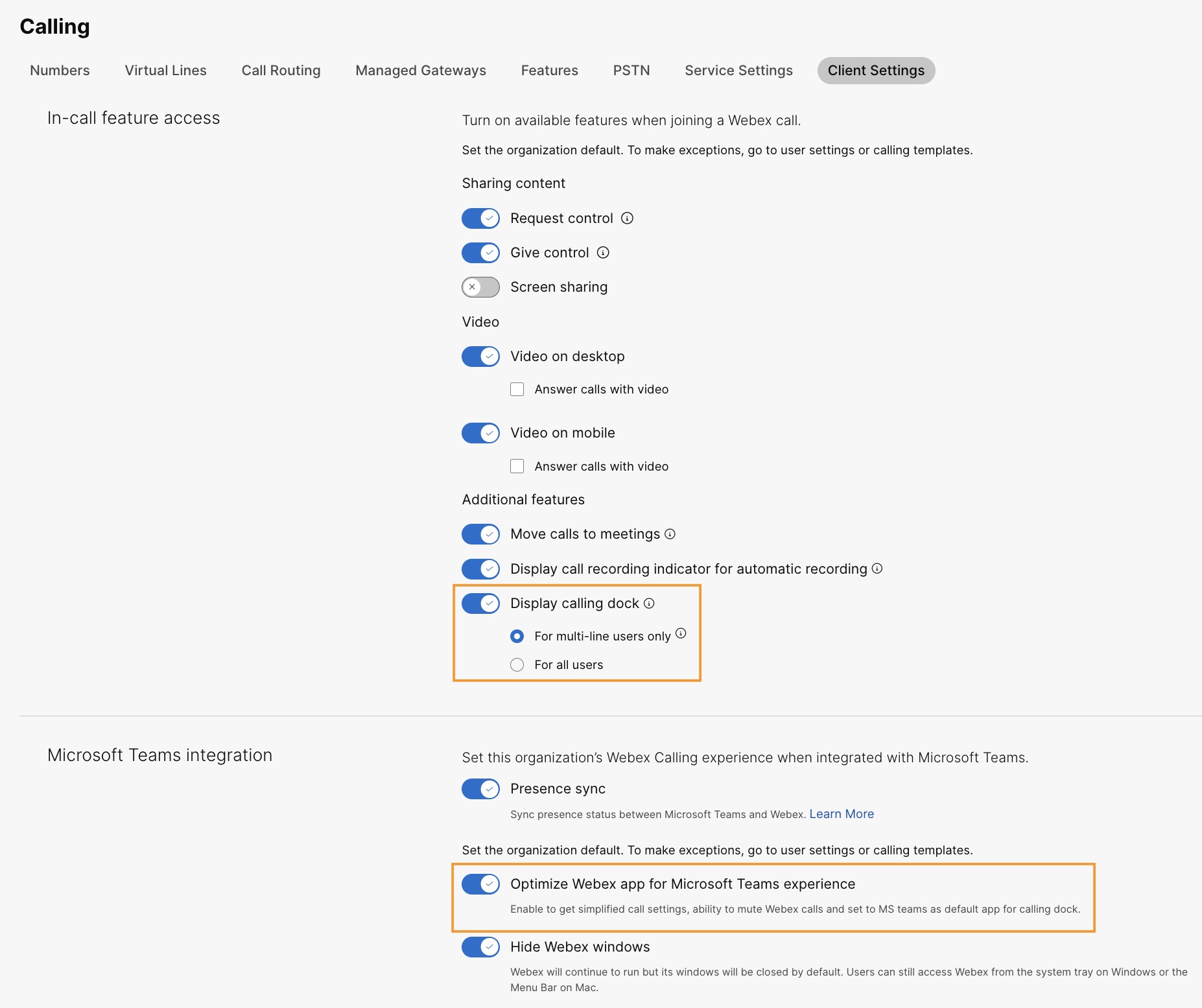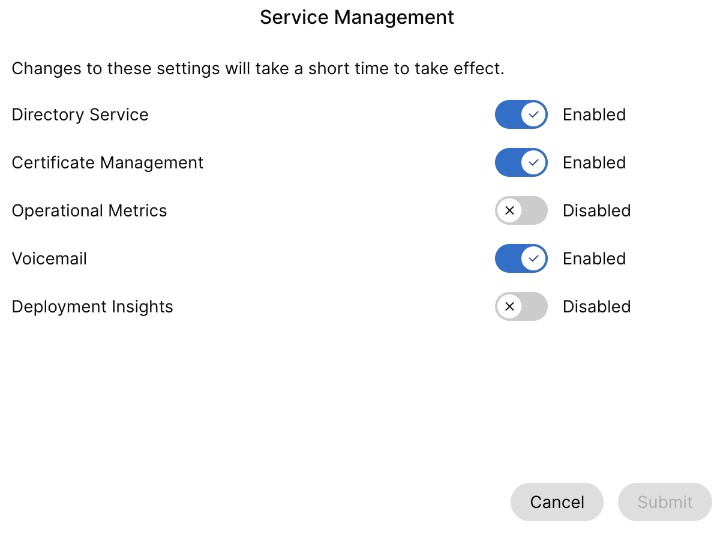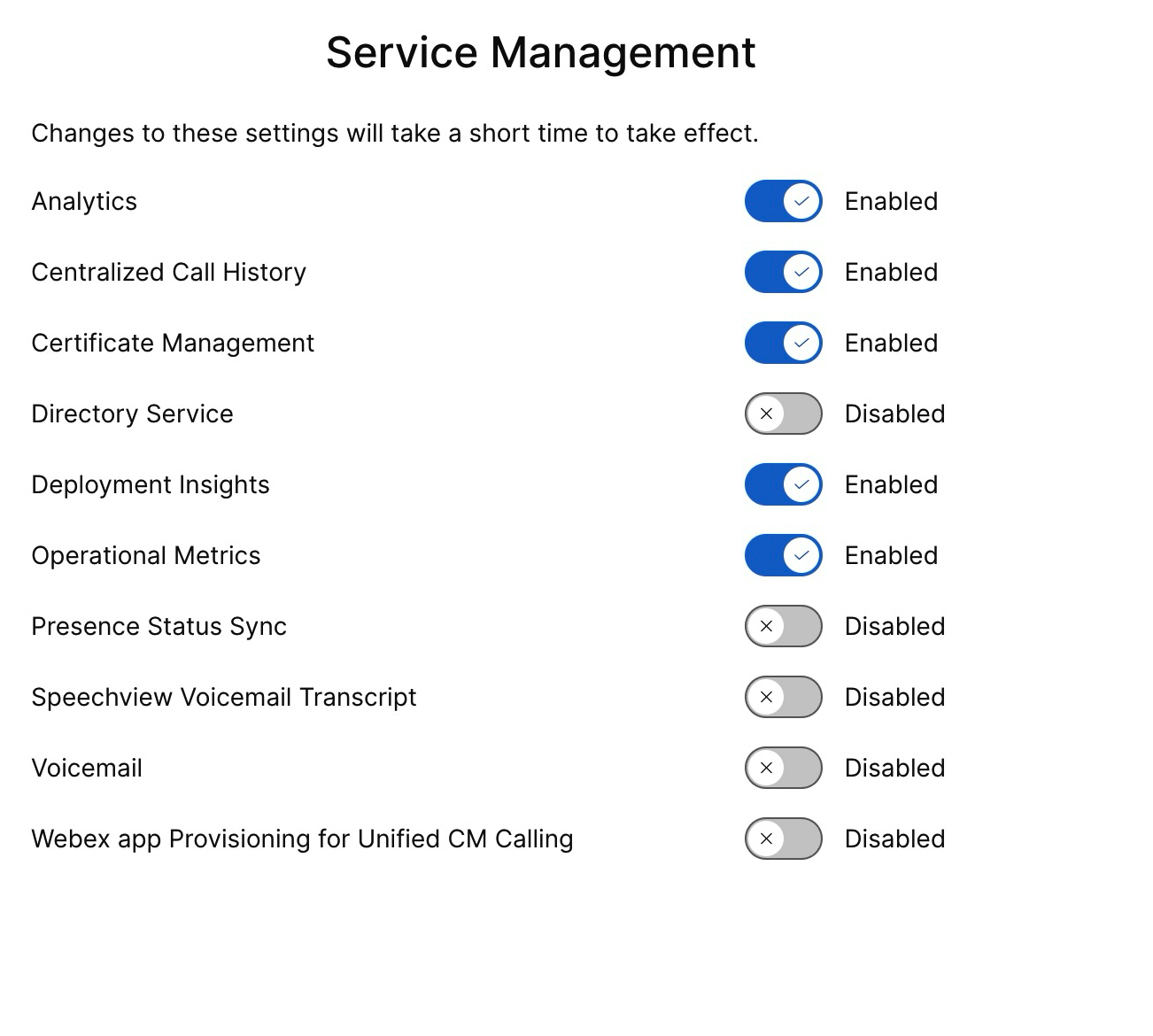- Home
- /
- Articolo



Configurare Cisco Call per Microsoft Teams
 In questo articolo
In questo articolo Feedback?
Feedback?Installa Cisco Call come opzione di chiamata predefinita per tutti gli utenti della tua organizzazione.
Utilizza questo articolo per configurare l'app Microsoft Teams con le opzioni di chiamata Cisco. L'icona ![]() è stata aggiunta alla navigazione a sinistra e come estensione di messaggistica. Con l'opzione di chiamata Teams disattivata, tutte le persone all'interno dell'organizzazione utilizzano la stessa piattaforma per effettuare e ricevere chiamate.
è stata aggiunta alla navigazione a sinistra e come estensione di messaggistica. Con l'opzione di chiamata Teams disattivata, tutte le persone all'interno dell'organizzazione utilizzano la stessa piattaforma per effettuare e ricevere chiamate.
Prerequisiti
-
Assicurati di essere un amministratore di Microsoft Teams.
-
Assicurati di avere accesso al Control Hub.
-
Verificare che gli utenti abbiano assegnato licenzein Control Hub e siano registrati su Cisco Unified Communications Manager o Webex Calling per effettuare chiamate.
-
Gli utenti devono avere installato l'app Webex e Microsoft Teams.
-
Affinché l'integrazione di Cisco Call for Microsoft Teams funzioni con il backend di controllo delle chiamate di Unified CM (in locale, istanza dedicata di Webex Calling o UCM Cloud), assicurati di utilizzare Unified CM 12.5 SU7 o 14 SU3, Cisco Unity Connection (CUC) 12.5 o 14.
-
Per i clienti Unified CM on-premise, assicurarsi Unified CM & I cluster CUC sono integrati in Webex Cloud-Connected UC (CCUC).
-
Gli utenti devono essere sincronizzati da Active Directory in sede o da Cloud AD, ad esempio da Azure a Control Hub Common Identity (CI).
-
Per i clienti locali, Webex Calling Dedicated Instance e UCM Cloud, Configura Cisco Unified CM—Il numero di linea su Cisco Unified CM deve essere associato all'ID utente affinché la cronologia delle chiamate centralizzata venga popolata con il nome utente. Da Cisco Unified CM Administration, utilizzareDispositivo→Telefono, selezionare il telefono e fare clic suNome dispositivo (linea), quindi fare clic sulla linea richiesta dal pannelloAssociazioneper arrivare aUtente associato alla linea.
-
Assicurarsi che l'ID e-maildi Unified CM corrisponda all'e-mail principale di Control Hub, utilizzata per ottenere l'identificatore univoco universale (UUID).
-
Infrastruttura desktop virtuale (VDI): Quando l'integrazione di Cisco Call per Microsoft Teams viene utilizzata in un ambiente VDI, sia Cisco Call che Microsoft Teams devono essere in esecuzione sulla stessa macchina virtuale.
Configurazione di Microsoft Teams
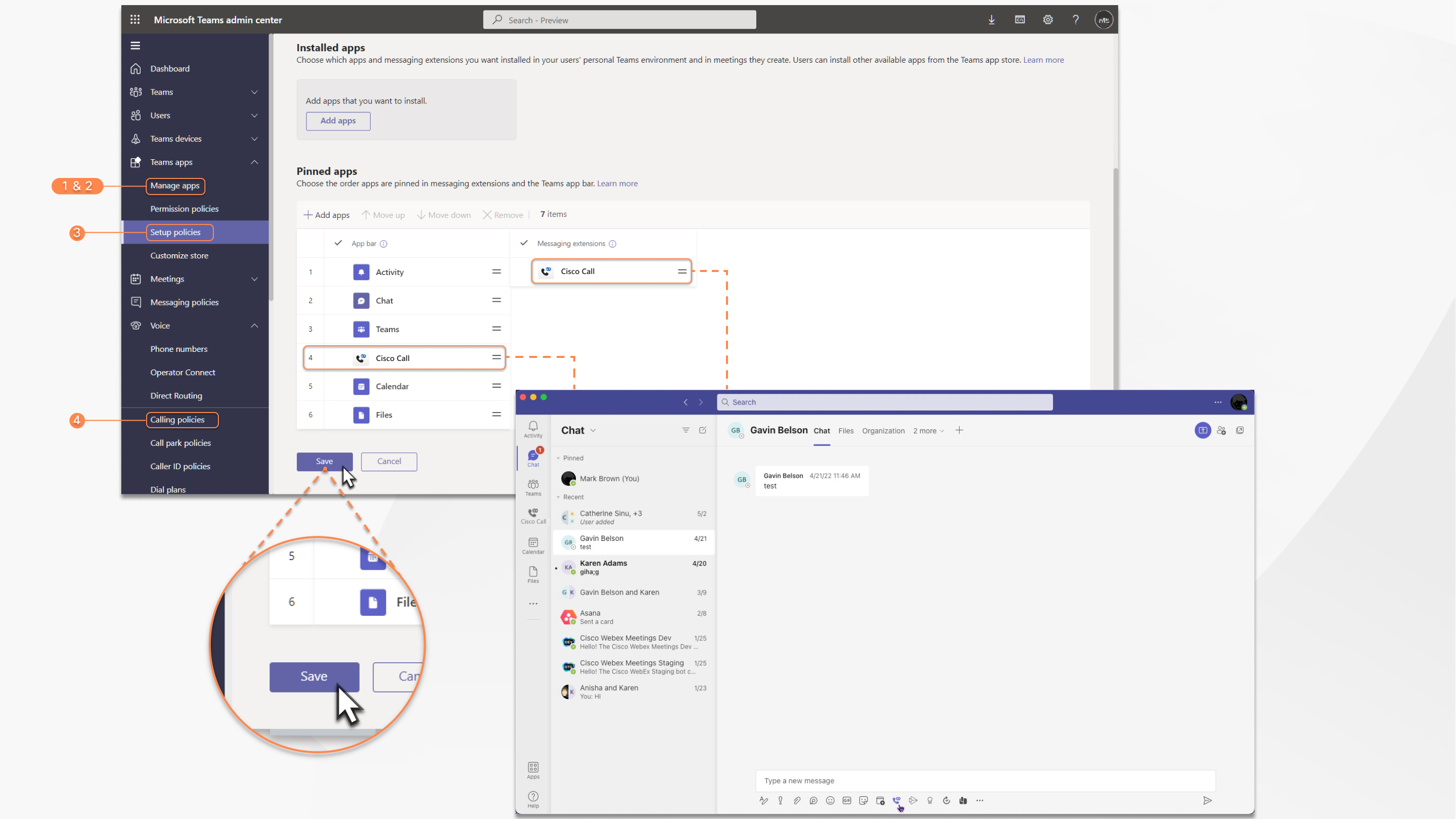
| 1 |
Accedi al Centro di amministrazione di Teams per gestire le tue app e consentire Cisco Call. |
| 2 |
Gestisci chi può installare Cisco Call. |
| 3 |
Installa Cisco Call, quindi aggiungi l'icona all'app Webex e rimuovi l'opzione di chiamata integrata. |
| 4 |
Facoltativo: disabilitare l'opzione di chiamata integrata in tutta l'organizzazione e impostare Cisco Call come unica opzione di chiamata:
|
Accetta le autorizzazioni di sincronizzazione della presenza
Rivedere e accettare le autorizzazioni di sincronizzazione della presenza in Microsoft Teams per sincronizzare in modo bidirezionale lo stato di presenza dell'utente tra Microsoft Teams e Webex.
Per mantenere attiva la sincronizzazione della presenza, gli utenti devono utilizzare l'integrazione Cisco Call almeno una volta ogni 90 giorni.
| 1 |
Nel menu Dashboard, vai a |
| 2 |
Nella casella di ricerca, inserisci |
| 3 |
Fare clic sulla scheda Autorizzazioni, quindi fare clic su Concedi consenso amministratore. |
| 4 |
Controllare se sono incluse le seguenti autorizzazioni.
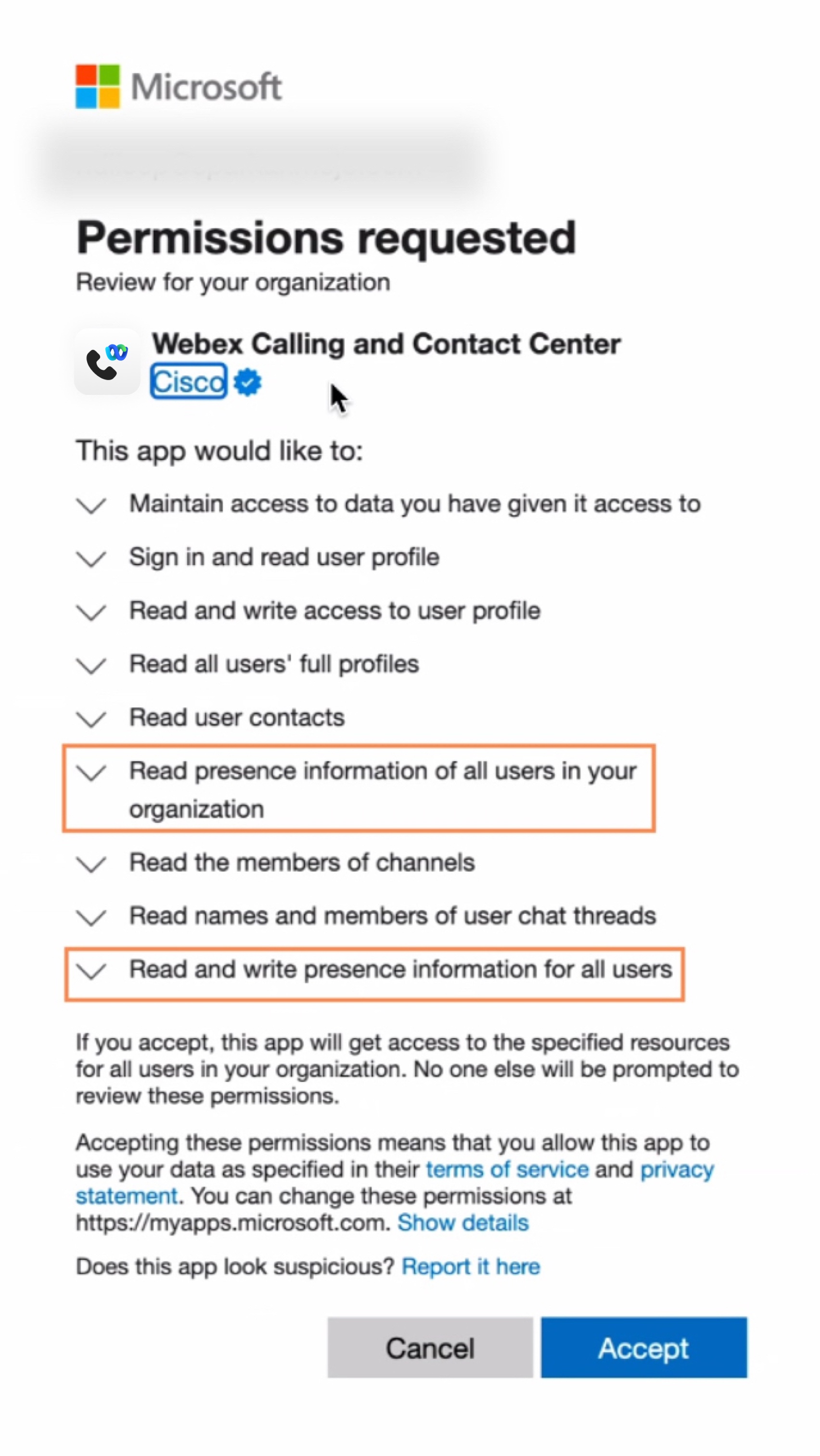 |
| 5 |
Fare clic su Accetta per accettare le autorizzazioni. |
| 6 |
Assicurati che le nuove autorizzazioni vengano visualizzate come concesse:
Nel consenso dell'amministratore devono essere rispettate le seguenti autorizzazioni:
Sia le autorizzazioni
Se la tua organizzazione utilizza attualmente l'autorizzazione Se vuoi spostarti solo da Dopo aver verificato le autorizzazioni, abilita la sincronizzazione della presenza nel Control Hub. Fare riferimento alla sezione Abilita sincronizzazione presenza bidirezionale. Per evitare problemi con lo stato di sincronizzazione della presenza tra Microsoft Teams e Webex, ti consigliamo di impostare l'impostazione Assegnazione richiesta su No. Per aggiornare l'impostazione, vai al centro di amministrazione di Microsoft Entry o al portale di Azure e vai a e seleziona No. Se per qualsiasi motivo è necessario mantenere questa impostazione su Sì, assicurarsi di assegnare gli utenti correttamente seguendo i passaggi indicati nei seguenti documenti Microsoft: Assegna ruoli app alle applicazioni & Gestire l'assegnazione di utenti e gruppi a un'applicazione. |
Personalizza l'app Cisco Call
È possibile creare più personalizzazioni dell'app Cisco Call per gli utenti di Microsoft Teams in base alle esigenze della propria organizzazione. È possibile creare una personalizzazione predefinita dell'app per tutti gli utenti oppure creare 10 personalizzazioni aggiuntive di una singola app e assegnarle a utenti o gruppi specifici.
Per ulteriori informazioni, vedere Personalizzare l'app Cisco Call per gli utenti di Microsoft Teams.
Autorizzazioni per l'integrazione tra Cisco Call e Microsoft Teams
Il servizio di integrazione utilizza le API Webex e Microsoft per accedere ai dati, come la cronologia centralizzata delle chiamate, per visualizzare e aggiornare gli stati, ad esempio contrassegnando i messaggi vocali come letti, senza memorizzare alcun dato utente. Tutti i trasferimenti di dati tra l'integrazione e il Webex/Microsoft i backend avvengono su canali HTTPS crittografati. In questo modo, il servizio garantisce che i dati degli utenti non vengano archiviati nel cloud, rafforzando la privacy e la sicurezza dei dati.
Richiediamo a Microsoft le autorizzazioni minime richieste per chiamare l'API Microsoft e abilitare la funzionalità di integrazione. Nella tabella seguente vengono descritte tutte le autorizzazioni che richiediamo e il motivo per cui sono necessarie.
| Autorizzazione | Motivo |
|---|---|
|
offline_access |
Consente al servizio di integrazione di generare un nuovo token di accesso senza chiedere spesso all'utente di effettuare una nuova autorizzazione. |
|
User.Read |
Consente al servizio di integrazione di leggere le informazioni di base dell'utente, come l'indirizzo e-mail. |
|
Utente.LetturaScrivi |
Consente al servizio di integrazione di memorizzare le chiamate rapide nei profili utente. |
|
User.Read.All |
Consente al servizio di integrazione di cercare utenti nella directory attiva per effettuare chiamate. |
|
Contatti.Leggi |
Consente al servizio di integrazione di cercare il contatto Outlook dell'utente per effettuare chiamate. |
|
ChannelMember.Read.All |
Consente all'estensione del messaggio di integrazione di leggere i membri di un canale in modo che l'utente possa cercare un membro specifico del canale da chiamare. |
|
Chat.ReadBasic |
Consente all'estensione del messaggio di integrazione di leggere i membri di una chat di gruppo in modo che l'utente possa cercare un membro specifico da chiamare. |
|
Presenza.Leggi.Tutto |
Consente al servizio di integrazione di leggere le informazioni sulla presenza di tutti gli utenti nella directory. |
|
Presenza.Lettura.Scrivi.Tutto |
Consente al servizio di integrazione di leggere tutte le informazioni sulla presenza e di scrivere l'attività e la disponibilità di tutti gli utenti nella directory. |
|
Presenza.LetturaScrivi |
Consente al servizio di integrazione di leggere le informazioni sulla presenza e di scrivere l'attività e la disponibilità di un utente. |
Configurazione del Control Hub
È possibile configurare e abilitare le seguenti funzionalità in Control Hub per renderle disponibili agli utenti di Microsoft Teams.
Nascondi la finestra dell'app Webex
Per le organizzazioni che hanno scelto di utilizzare l'integrazione di Cisco Call con Microsoft Teams, l'integrazione rappresenta l'interfaccia principale degli utenti per i servizi Webex. Una volta configurata, l'app Webex rimane installata e in esecuzione sui computer degli utenti, ma la sua finestra verrà chiusa per impostazione predefinita. Le azioni eseguite nell'integrazione di Cisco Call possono avviare funzionalità specifiche nell'app Webex, ma in genere gli utenti non hanno bisogno di interagire con l'app Webex.
Tramite Control Hub, è possibile nascondere la finestra dell'app Webex ai seguenti livelli:
-
Livello organizzativo
-
Livello di gruppo di utenti
-
Livello utente
Nascondere la finestra dell'app Webex per un'organizzazione
Le impostazioni configurate a livello di organizzazione si applicano automaticamente a tutti gli utenti dell'organizzazione.
| 1 | |
| 2 |
Vai a . |
| 3 |
Fare clic sulla scheda App Webex, andare alla sezione Integrazione Microsoft Teams e attivare Nascondi finestre Webex.
È anche possibile utilizzare l'API pubblica per nascondere la finestra dell'app Webex per tutti gli utenti di un'organizzazione che utilizzano l'integrazione Cisco Call con Microsoft Teams. Per i dettagli, vedere Aggiornare le impostazioni MS Teams di un'organizzazione in developer.webex.com. |
Nascondi la finestra dell'app Webex per un gruppo di utenti
Per nascondere la finestra dell'app Webex per un gruppo di utenti, creare un modello di chiamata e assegnarlo a un gruppo di utenti. La configurazione nel modello si applica a tutti gli utenti del gruppo.
Per creare un nuovo modello per nascondere la finestra dell'app Webex:
| 1 | |
| 2 |
Vai a . |
| 3 |
Fare clic su Crea modello, scegliere Crea un modello e fare clic su Avanti. Se l'istruzione è il settore verticale della tua attività, puoi applicare modelli predefiniti con impostazioni personalizzate per studenti o insegnanti. |
| 4 |
Nella sezione Generale, digitare il Nome modello e la Descrizione. |
| 5 |
Vai alla sezione Integrazione con Microsoft Teams e attiva Nascondi finestre Webex. |
| 6 |
Fare clic su Crea modello e avanti. |
| 7 |
Cerca e seleziona un gruppo per questo modello e fai clic su Fatto. Modificare o eliminare un modello:
Per modificare un modello, fare clic sul modello, modificare i pulsanti di attivazione/disattivazione e fare clic su Salva. Per eliminare un modello, fare clic sul modello e scegliere Elimina dall'elenco a discesa Azioni. Nella pagina Elimina modello, seleziona la casella che informa che l'eliminazione di un modello è permanente, quindi fai clic su Elimina. |
Considerazioni sull'applicazione dei modelli di chiamata a un gruppo di utenti
-
Quando un utente è a livello di organizzazione, l'utente eredita le impostazioni a livello di organizzazione.
-
Se l'utente viene aggiunto a un gruppo di utenti, vengono applicate le impostazioni del modello chiamata.
-
Se un utente appartiene a più gruppi di utenti, il modello con il grado più alto (grado 1) ha la precedenza e vengono applicate le impostazioni di quel modello.
-
Se l'utente dispone di impostazioni utente individuali, queste hanno la precedenza sulle impostazioni a livello di gruppo utente o di organizzazione.
Per ulteriori informazioni sulla gestione dei modelli, vedere Configurare i modelli di impostazioni.
È possibile applicare il modello esistente dalla sezione Gruppo o dalla sezione Chiamata.
- Per applicare il modello dalla sezione Gruppo, vedere Configurare il modello delle impostazioni.
- Per candidarsi dalla sezione Calling, completare i seguenti passaggi.
| 1 | |
| 2 |
Vai a . |
| 3 |
Fare clic su |
| 4 |
Digitare il nome del gruppo a cui si desidera applicare il modello, quindi selezionare il gruppo. |
| 5 |
Fare clic su Operazione completata. |
Nascondi la finestra dell'app Webex per un utente
Le impostazioni individuali degli utenti hanno la precedenza sulle impostazioni a livello di organizzazione e di gruppo di utenti.
| 1 | |
| 2 |
Vai a . |
| 3 |
Selezionare un utente e fare clic su Chiamata. |
| 4 |
Vai a Esperienza di chiamata utente e fai clic su Integrazione con Microsoft Teams. |
| 5 |
Attiva Nascondi finestre Webex. 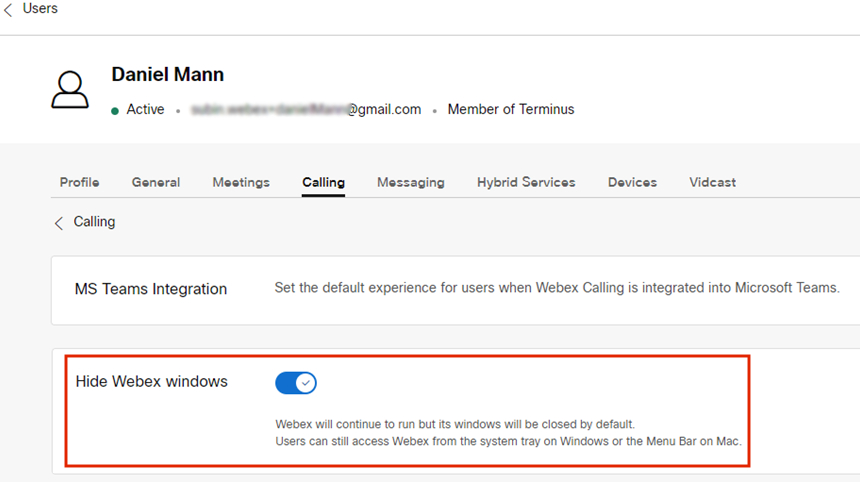 Dopo aver configurato le impostazioni per un utente, è possibile modificarle ulteriormente a livello di utente. Le impostazioni utente non tornano automaticamente alle impostazioni predefinite di un'organizzazione. È possibile utilizzare l'API pubblica per nascondere la finestra dell'app Webex dal client Microsoft Teams per un singolo utente. Vedere Configurare le impostazioni di MS Teams di una persona e Recuperare le impostazioni del servizio applicativo di una persona in developer.webex.com. |
Dopo aver configurato le impostazioni, gli utenti devono riavviare l'app Webex e accedere per visualizzare la modifica.
Se gli utenti desiderano interagire con l'app Webex stessa, possono accedervi dalla barra delle applicazioni su Windows e dalla barra dei menu su Mac. L'app Webex è visibile solo nella barra delle applicazioni di Windows o nel dock di macOS quando una finestra è attiva e in uso.
|
App Webex nella barra delle applicazioni di Windows |
App Webex nella barra dei menu del Mac |
Abilita la chiamata alla finestra del dock
La finestra di chiamata (chiamata multipla) è una finestra separata e mobile che aiuta gli utenti a gestire più linee o linee condivise in un'unica finestra. Gli utenti possono effettuare e ricevere chiamate, visualizzare lo stato di tutte le linee e avere un migliore accesso a funzioni come attesa, trasferimento e inclusione, senza dover passare a un'altra finestra.
| 1 | |
| 2 |
Vai a . |
| 3 |
Fare clic sulla scheda App Webex, andare alla sezione Accesso alle funzionalità in chiamata e in Funzionalità aggiuntive, attivare Visualizza dock chiamate e scegliere una delle seguenti opzioni:
È possibile configurare questa funzionalità anche a livello di gruppo di utenti e di singolo utente.
|
Ottimizza l'app Webex per l'esperienza Microsoft Teams
Questa funzionalità offre agli utenti le seguenti esperienze:
-
Impostazioni di chiamata semplificate: le impostazioni di chiamata visualizzano solo le opzioni necessarie per l'integrazione. L'attivazione di questa funzione semplifica solo le impostazioni di chiamata accessibili tramite Calling Dock. Per impostazione predefinita, le impostazioni di chiamata accessibili dall'integrazione Cisco Call rimangono semplificate.
-
Disattiva audio chiamate Cisco: le chiamate Cisco in arrivo vengono disattivate quando un utente è impegnato in una chiamata o riunione Microsoft Teams. Per utilizzare questa funzionalità, è necessario abilitarla in Control Hub e l'utente deve abilitare l'opzione Disattiva l'audio delle notifiche solo quando sono in riunione o in chiamata dalle impostazioni di chiamata nell'integrazione Cisco Call.
Se si disabilita questa funzionalità in Control Hub, le impostazioni utente funzioneranno solo quando l'utente è impegnato in una chiamata o riunione Cisco. Se si abilita questa funzionalità, le impostazioni utente funzioneranno quando l'utente è impegnato in una chiamata o riunione di Microsoft Teams oppure in una chiamata o riunione di Cisco.
-
Esperienza con un'unica app: quando un utente fa clic sulle icone della segreteria telefonica e della cronologia delle chiamate centralizzata dal dock delle chiamate, viene reindirizzato a Microsoft Teams Cisco Call anziché all'app Webex.
Utenti Windows: Facendo clic sull'app Webex nella barra delle applicazioni si apre il dock delle chiamate anziché l'app Webex.
| 1 | |
| 2 |
Vai a . |
| 3 |
Fare clic sulla scheda App Webex, andare alla sezione Integrazione con Microsoft Teams e attivare Ottimizza app Webex per l'esperienza Microsoft Teams.
Questa opzione è disabilitata se non hai abilitato l'opzione Visualizza dock chiamate nella sezione Accesso alle funzionalità in chiamata. È possibile configurare questa funzionalità anche a livello di gruppo di utenti e di singolo utente.
|
Abilita la segreteria telefonica, la cronologia centralizzata delle chiamate e la sincronizzazione della presenza
Segreteria telefonica e cronologia chiamate centralizzata
Le funzioni di segreteria telefonica e cronologia centralizzata delle chiamate sono abilitate per impostazione predefinita per i clienti Webex Calling, Dedicated Instance e UCM Cloud.
Per ulteriori informazioni sull'abilitazione della segreteria telefonica per gli utenti di Webex Calling, vedere: Configurare e gestire le impostazioni della segreteria telefonica per un utente Webex Calling.
Per ulteriori informazioni sull'abilitazione della segreteria telefonica per gli utenti BroadWorks, vedere Abilitazione della segreteria telefonica per l'integrazione con Microsoft Teams.
Per garantire il corretto funzionamento di questa funzionalità, gli amministratori di BroadWorks devono abilitare la cronologia centralizzata delle chiamate unificata. Per informazioni più dettagliate, vedere Guida alla configurazione di Webex per Cisco BroadWorks.
Sincronizzazione presenza bidirezionale
Questa funzionalità consente la sincronizzazione bidirezionale dello stato di presenza tra Microsoft Teams e Webex, supportando più tenant di Microsoft Teams nella stessa organizzazione Webex. Lo stato di presenza include In una chiamata, In una riunione, In presentazione, e Non disturbare.
Dopo aver abilitato questa funzione, quando un utente effettua o riceve una chiamata Webex, il suo stato Microsoft Teams viene modificato in In una chiamata. Quando si abilita Non disturbare nell'app Webex o in qualsiasi dispositivo Webex, lo stato viene sincronizzato automaticamente con Microsoft Teams. Allo stesso modo, gli stati In riunione e Presentazione vengono sincronizzati tra le applicazioni.
Quando l'opzione Non disturbare è abilitata sull'app Webex dell'utente o su qualsiasi dispositivo Webex, l'utente non riceverà alcuna notifica di chiamata in arrivo e messaggi nell'app Webex, nel dispositivo Webex o in Microsoft Teams.
È anche possibile utilizzare l'API pubblica per abilitare la sincronizzazione della presenza Webex con il client Microsoft Teams. Per i dettagli, vedere Aggiornare le impostazioni MS Teams di un'organizzazione in developer.webex.com.
La tabella seguente mostra la rappresentazione della sincronizzazione dello stato bidirezionale tra Webex e Microsoft Teams.
|
Stato Webex |
Stato di Microsoft Teams |
|---|---|
|
|
|
|
|
|
|
|
|
|
|
|
Attualmente è possibile configurare questa funzionalità solo a livello di organizzazione.
| 1 | |
| 2 |
Vai a . |
| 3 |
Fare clic sulla scheda App Webex, andare alla sezione Integrazione Microsoft Teams e attivare Sincronizzazione presenza. Per un'esperienza ottimale, puoi attivare l'opzione Nascondi finestre Webex, ma è facoltativa. |
| 4 |
Vai alla sezione Sincronizzazione dello stato Non disturbare (DND) e attiva l'interruttore. 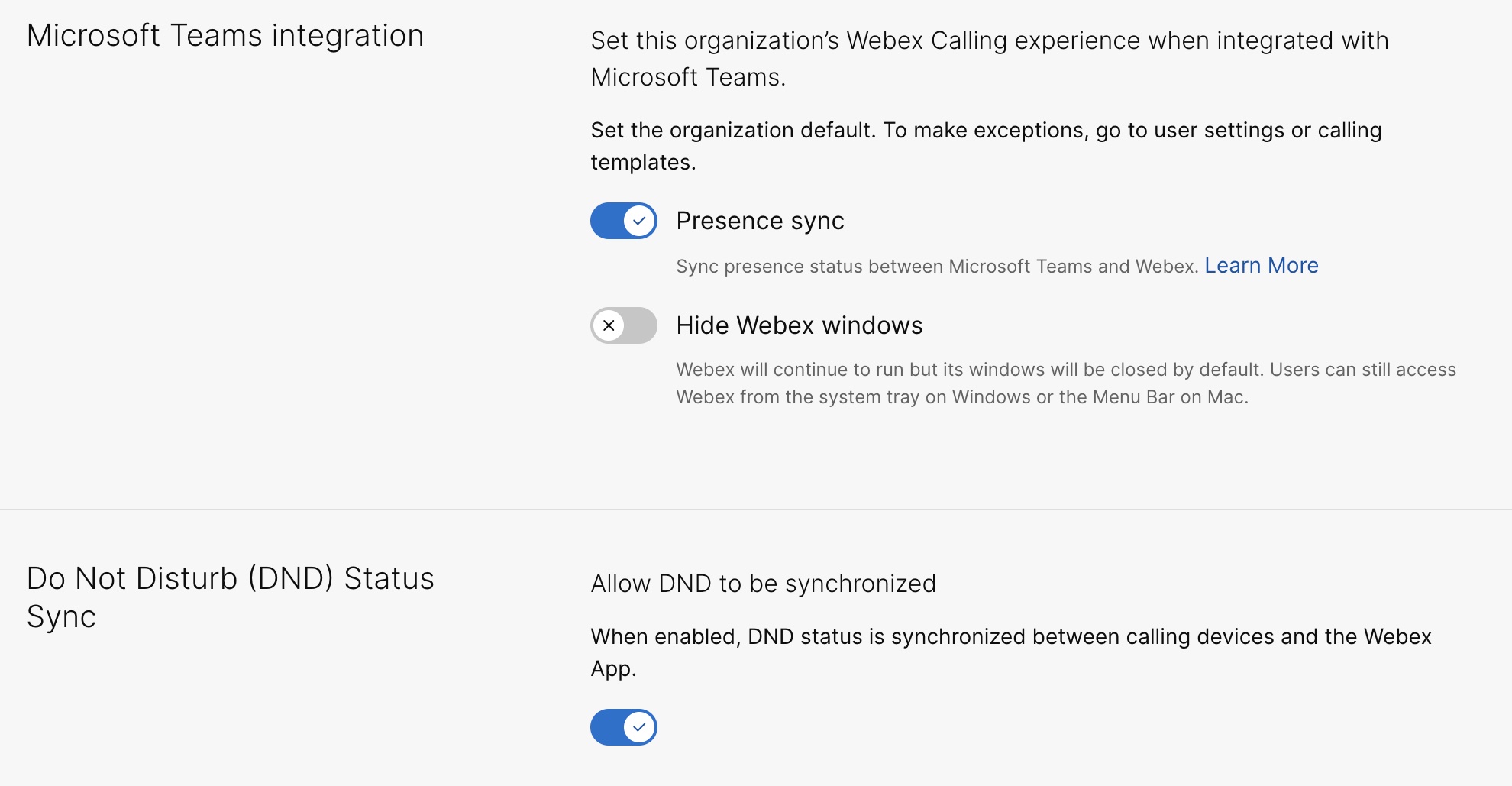 |
Configurazione aggiuntiva per gli utenti Unified CM
Per abilitare la segreteria telefonica, la cronologia centralizzata delle chiamate e il servizio di sincronizzazione della presenza bidirezionale per i clienti Unified CM in sede, procedere come segue:
L'attivazione del servizio di segreteria telefonica abilitato per i clienti in sede richiede al massimo 12 ore.
| 1 | |||||
| 2 |
Vai a . Nella scheda UC Management, fai clic su Inventario. Viene visualizzato l'elenco di gruppi di cluster con la descrizione, lo stato, i cluster e i nodi. | ||||
| 3 |
Eseguire le seguenti azioni:
Viene visualizzata la pagina Inventario, che mostra l'elenco dei cluster appartenenti al gruppo di cluster selezionato. | ||||
| 4 |
Fai clic su Dettagli accanto al cluster a cui appartiene il nodo di prodotto specifico. Viene visualizzato il nome del nodo con la versione, il prodotto e lo stato. | ||||
| 5 |
Fai clic sull'icona dei puntini di sospensione ⋮ accanto a Cronologia eventi e scegli Gestione servizi. Viene visualizzata la pagina Gestione servizi con l'elenco dei servizi. | ||||
| 6 |
Utilizzare il pulsante di attivazione/disattivazione per abilitare la Segreteria telefonica, Cronologia chiamate centralizzata e Sincronizzazione dello stato di presenza.
| ||||
| 7 |
Fare clic su Invia. | ||||
| 8 |
Se viene visualizzato il pop-up Conferma raccolta dati, accettarlo abilitando la casella di controllo e fare clic su Invia. |

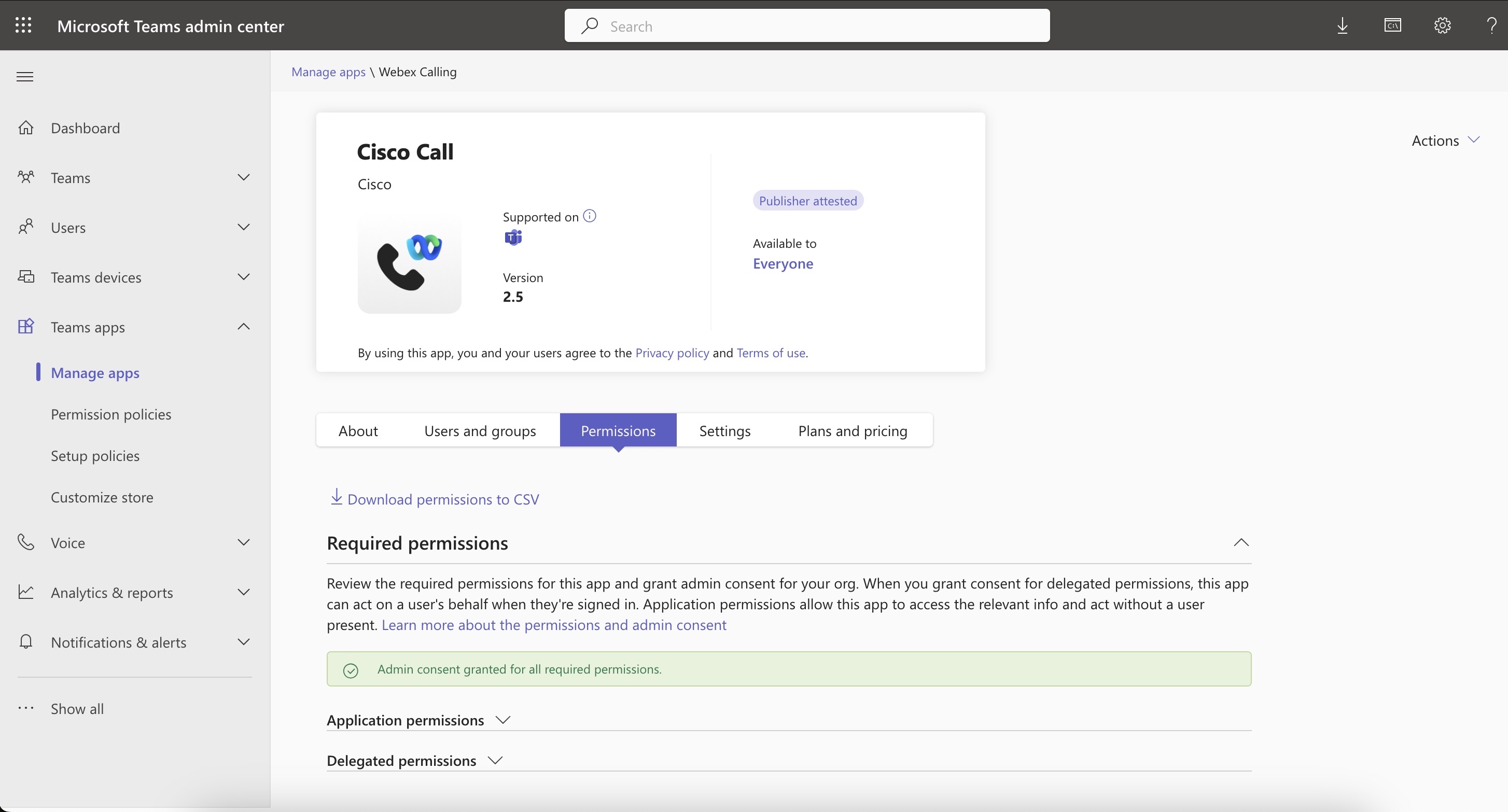
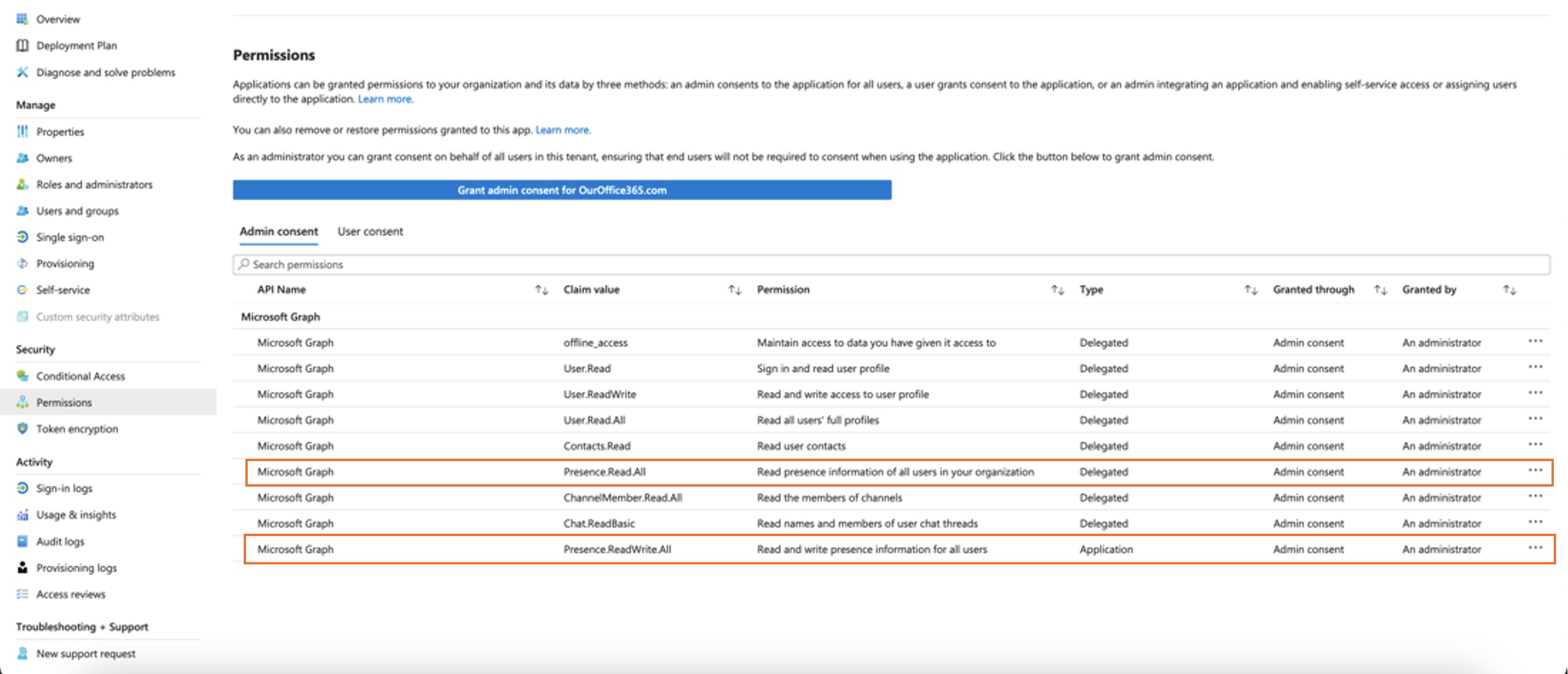
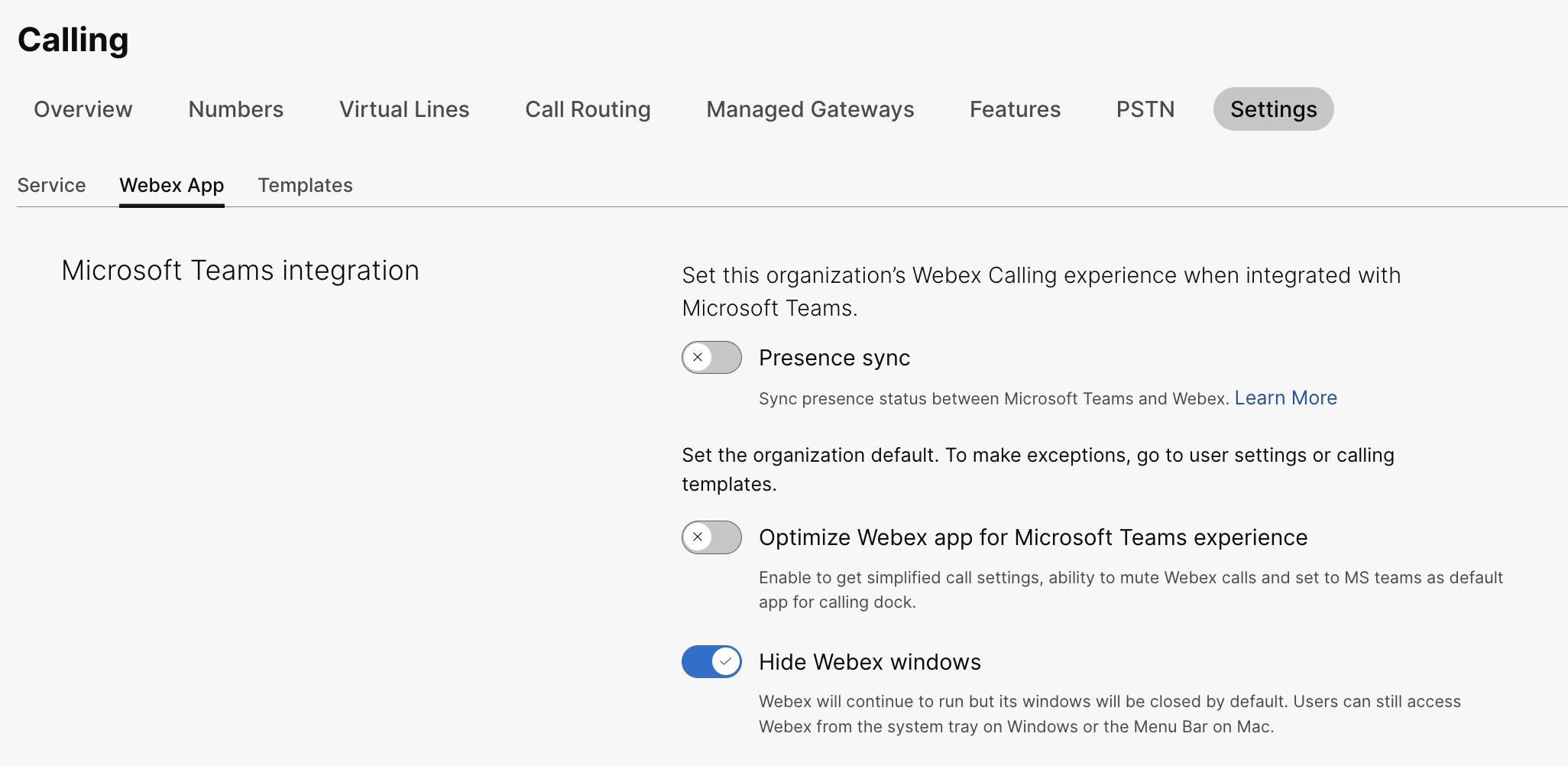
 accanto a un modello esistente e fare clic su
accanto a un modello esistente e fare clic su 